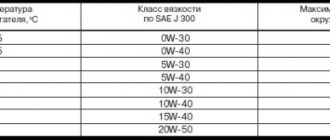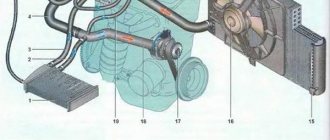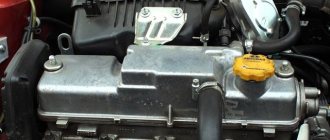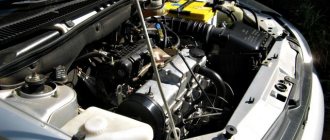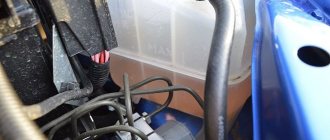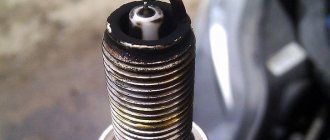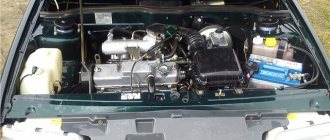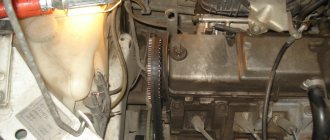Almost every motorist has come across the concept of engine overheating, but not everyone knows why it occurs. Also, in this article we will talk about how to avoid such a phenomenon on a Lada Kalina car (regardless of whether it has an 8 or 16 valve engine, the reasons are basically always the same), correct faults and consider the recommendations of experts and the experience of motorists. The main reason why overheating occurs (4th error on the instrument panel) is a malfunction in the engine cooling system, as well as, in rare cases, accumulated errors in the engine control unit. So, let's look at the main reasons for overheating of the main power unit of the Lada Kalina: 1
. Clogged engine cooling radiator and cooling lines.
2
.
Stretched water cooling belt, as well as pump malfunction. 3
. Stuck thermostat.
Diagram of the working thermostat.
If there is a malfunction, it jams into a small circle, which is why the car gets very hot 4
. Failure of the engine cooling sensor.
Location of the coolant sensor
5
. Cooling fan malfunction. May be caused by a broken fan relay or blown fan fuse.
Cleaning the cooling radiator from debris
All these elements are part of the cooling system, which can fail and lead to engine overheating.
But there are other reasons that lead to internal overheating of the power unit. There are several of them: 1
.
Large volumes of deposits inside the combustion chamber. This problem usually occurs in old cars that have traveled hundreds of thousands of kilometers. Excessive oil enters the engine combustion chamber. The latter burns poorly and leaves a harmful coating on the cylinder walls. As a result, the engine overheats, but the temperature sensor does not sense this and does not give a signal to the driver. The problem will only be noticeable if additional signs appear—blue smoke from the exhaust pipe or malfunctions in the power unit. 2
.
Plaque in the cooling cavity. If you pour water into the cooling system or low-quality antifreeze, then deposits may appear on the walls of the components and tubes, which disrupts the cooling processes. As a result, many channels may be blocked, and the access of fluid to the system is disrupted. A deposit of mineral salts leads to a sharp decrease in the quality of engine cooling and, as a result, its overheating. 3
. Oil additives. There are car enthusiasts who thoughtlessly add additives to motor oil, without even knowing their true purpose. As a result, a powerful coating can form on the cylinder walls, which disrupts the quality of engine cooling and leads to its inevitable overheating.
Lada Kalina is heating up: one of the possible reasons
Much has been written and said about the fact that Kalina constantly operates at high temperatures, supposedly this is almost the norm for her, due to defects in the cooling system. There was nothing like this on the car in question, at least until a certain point. This is not the case now. The malfunction was identified, albeit with great difficulty, and corrected in a timely manner. True, this is a special case, but far from rare. Maybe this material will help everyone who warms up Kalina to save a lot of hassle, time and money.
Preface
The viburnum that will be discussed was used for about two years without any problems. The temperature never exceeded 90 degrees, maybe a little more, the fan was constantly on, the antifreeze level did not change. Even when traveling to the resorts of the Krasnodar Territory, in the terrible heat and in numerous traffic jams, the instrument needle did not come close to the red sector.
It all started unexpectedly, as always. During a completely normal trip through the evening city, without traffic jams, numerous stops at traffic lights, etc. The temperature gauge suddenly began to show about 100 degrees, and this was in winter. It was about 500m. from the garage, so the car was soon examined under the dim light of an electric lamp.
The first thing that caught my eye was the full expansion tank, which of course is not surprising. The viburnum became very hot, the antifreeze expanded and filled the expander. All other manipulations were transferred to daylight hours. In the morning, nothing had changed, the same full tank, and it was -10C outside and the engine, naturally, was completely cold. We start the engine, Kalina heats up faster than usual, the temperature is over 90C, and the radiator is cold. From that moment it became clear that it was not possible to get away with “little blood”.
Troubleshooting
As usual in such cases, there were many advisers and “specialists” nearby. In summary, possible malfunctions were as follows:
- Airlock.
- Expansion tank plug.
- Thermostat.
- Water pump.
- Cylinder head gasket.
It was in this sequence that the votes of numerous advisers were distributed. Now all that remained was to test each of the assumptions.
Airlock
This reason for the overheating of the Kalina engine explained the antifreeze that did not leave the expander during cooling. There is an air lock in the system and it is this that prevents the coolant from returning to it. Without thinking too much about where such an amount of air could come from, we bleed it through the throttle assembly heating hose. True, in this case Kalina has an electronic pedal, but it has a similar tube. The air came out, the level of antifreeze in the barrel dropped, and to do this we had to open the expansion cap. True, there is slightly less antifreeze, but it doesn’t matter - we top it up.
Kalina traveled all day. Everything was as usual, the engine did not heat up, no one looked under the hood. True, at idle the stove barely warmed up, which was attributed to the air remaining in the system. In general, everything was fine for 50 kilometers, but by the evening Kalina heated up to 100C, and again the antifreeze expander was full. Air again, but where from?
Expansion plug
We change the expander cap, fortunately the cost is only 140 rubles. The air is released again. The decreased amount of antifreeze in the tank made me think. The second time cannot be an accident. The coolant is going somewhere. A quick inspection of the engine compartment revealed antifreeze leaks at the gearbox. Even the location of the leak was discovered - a clamp on the thermostat, the bolt on which was immediately tightened. We came to the conclusion that the cause had been discovered.
The fact is that at that time, it really seemed like the truth. The peculiarity of the Kalina cooling system is such that cooled antifreeze or antifreeze returns to the system not by gravity, but under the influence of the vacuum created during cooling. In this case, a prerequisite is the opening of the check valve on the expansion tank plug. If it does not open or is too tight, the system will most likely begin to suck air from all loose connections. Thus, the system is aired, and all the antifreeze remains in the tank. The situation is one to one.
But that was not the case. In the evening Kalina again warmed up mercilessly, the antifreeze was gone. Your own capabilities have been exhausted, you will have to go to a service center.
Thermostat
The usual unobtrusive scam began in the workshop. After describing the symptoms and what we managed to do on our own, the verdict was made - the thermostat, because the lower pipe is cold. Several types were immediately proposed and the cost of replacement was announced. I didn’t believe in the thermostat at all, for several reasons:
- The stove does not heat. If the thermostat is faulty, it will work even better.
- When the air is released, everything works as expected for quite a long time and the engine does not heat up.
- Where the air comes from, the thermostat is clearly not to blame.
In general, this idea was reluctantly abandoned.
water pump
This version was based on the fact that Kalina stops warming up at rpms above 2000. The pump's performance is low. Why suddenly, and again, why when there is no air everything is fine. As a result, they did not change the pump either. There was only one last thing left.
Cylinder head gasket
Actually, the version was assumed from the very beginning, but no one dared to voice it. It is difficult to verify this, and repairs are expensive, and you don’t want to tinker with an engine that has only traveled 50,000 km. Nothing to do. Compression is measured, there is practically no difference between the cylinders. The car floats a little, but not enough to pay attention to it. Especially since it’s winter outside. The exhaust does not smell anything. There are no bubbles in the expander. Two more symptoms were noticed:
- The upper radiator hose is very swollen, and it is almost impossible to push it through with your hand.
- The antifreeze has changed color a little. Not even the color, it still remained red, but before it was more transparent.
Suspicions intensified, and it was decided to unscrew the spark plugs. There was a small amount of carbon deposits in the first cylinder, which could have been ignored, but the other spark plugs were completely clean.
Based on this, we decide to replace the cylinder head gasket. Everything else was tried anyway. After the master removed the head, everything fell into place. The piston of the first cylinder was completely clean, even shiny, and there was no emulsion in the oil. You can exhale - the money was not wasted and the reason has been established. The costs amounted to 4,000 rubles, including the change of antifreeze.
Summarize
If the cylinder head gasket is broken on Kalina, the symptoms will be as follows:
- The car will begin to quickly heat up in the simplest driving modes;
- The heater stops working or heats up at high speeds;
- The lower radiator hose is cold;
- When air is removed from the system, Kalina does not overheat for some time;
- The upper radiator hose is almost impossible to push through with your hands;
- Antifreeze changes color slightly;
- The car floats a little;
- I’m not sure, but, probably, if you bring the piston under TDC and shine a flashlight into the spark plug hole, you can see that the piston is clean, without carbon deposits.
Cabin filter
Every car has a cabin filter. It is through it that heated air from the stove (or cold air from the air conditioner) enters the cabin. If there were no cabin filter, then debris and dust, and sometimes fat particles (products of oil evaporation, for example) from the engine compartment would fly into the cabin. If this filter hasn't been changed in years, then there is a good chance that it is simply clogged and needs to be replaced. Air simply cannot pass through a dirty filter into the cabin, so it is not surprising that the stove on the Kalina does not heat the air well.
Solving this problem is quite easy: you need to remove the cabin filter and install a new one. It is located under the hood of the car, at the top left (near the front passenger seat). It can be accessed with just one screwdriver, and the cabin filter itself is cheap (its price is about 200 rubles).
Lada Kalina engine overheats reasons
Almost every motorist has come across the concept of engine overheating, but not everyone knows why it occurs. Also, in this article we will talk about how to avoid such a phenomenon on a Lada Kalina car (regardless of whether it has an 8 or 16 valve engine, the reasons are basically always the same), correct faults and consider the recommendations of experts and the experience of motorists. The main reason why overheating occurs (4th error on the instrument panel) is a malfunction in the engine cooling system, as well as, in rare cases, accumulated errors in the engine control unit. So, let's consider the main reasons for overheating of the main power unit of the Lada Kalina: 1. Clogged engine cooling radiator, as well as cooling lines. 2. Stretched water cooling belt, as well as pump malfunction. 3. Stuck thermostat. Diagram of the working thermostat. If there is a malfunction, it jams into a small circle, causing the car to become very hot 4. Failure of the engine cooling sensor. Location of the coolant sensor 5. Malfunction of the cooling fan. May be caused by a broken fan relay or blown fan fuse. Cleaning the cooling radiator from debris All these elements are part of the cooling system, which can fail and lead to engine overheating. But there are other reasons that lead to internal overheating of the power unit. There are several of them: 1. Large volumes of deposits inside the combustion chamber. This problem usually occurs in old cars that have traveled hundreds of thousands of kilometers. Excessive oil enters the engine combustion chamber. The latter burns poorly and leaves a harmful coating on the cylinder walls. As a result, the engine overheats, but the temperature sensor does not sense this and does not give a signal to the driver. The problem will only be noticeable if additional signs appear—blue smoke from the exhaust pipe or malfunctions in the power unit. 2. Plaque in the cooling cavity. If you pour water into the cooling system or low-quality antifreeze, then deposits may appear on the walls of the components and tubes, which disrupts the cooling processes. As a result, many channels may be blocked, and the access of fluid to the system is disrupted. A deposit of mineral salts leads to a sharp decrease in the quality of engine cooling and, as a result, its overheating. 3. Oil additives. There are car enthusiasts who thoughtlessly add additives to motor oil, without even knowing their true purpose. As a result, a powerful coating can form on the cylinder walls, which disrupts the quality of engine cooling and leads to its inevitable overheating. As a rule, the consequences of engine overheating depend on the efficiency of the motorist. The less the power unit operates in a dangerous mode, the lower the likelihood of damage to its units. For example, if the engine has been running in overheating mode for up to ten minutes, then you should not expect any serious problems - the engine and its components must withstand the effects of elevated temperatures with dignity. The worst that can happen is a slight melting of the piston surface. If, during the process of overheating, smoke poured out from under the hood, then it is better to show the car to a mechanic. In the case where the engine has been running under overheating conditions for about twenty minutes, the consequences can be more serious. The most common malfunctions in this case are the appearance of cracks in the cylinder head, its curvature, burnout of the gasket between the cylinder head and the block itself, damage to the seals, defects in the inter-ring partitions, and so on. Note! That severe overheating can lead to catastrophic consequences - it is tantamount to a “heart attack.” Failures can begin directly from the combustion chamber and completely immobilize the power unit. The piston system begins to melt, and traces of burnout appear. Melted aluminum sticks to the cylinder walls and further complicates engine operation. High temperatures lead to severe overheating of the oil. The result is the loss of all its lubricating characteristics and failure of rubbing parts. The connecting rod and main bearings begin to stick to the crankshaft, which also melt under high temperatures. And the crankshaft itself may not hold up and fall apart into several parts. The worst that can happen is that the connecting rod breaks through the wall of the cylinder block. Then you can put a “cross” on the engine. To avoid the problems described above, vigilance is required on the part of the motorist, and the engine itself needs effective protection against overheating. The main task is to use high-quality coolant with good additives and regularly check its level. There is no need to be lazy - it is important to look under the hood before every important trip at least once every 500-1000 kilometers. It is a good idea to periodically check the functionality of your car's thermostat. This is easy to do - just touch the car’s radiator with your hand (be careful not to accidentally get burned). If the engine is warmed up to operating temperature, but the radiator itself (or the pipe that supplies coolant) remains cold, then the thermostat has failed and requires repair. A working device should allow coolant access to a large circle already when it reaches 90-95 degrees Celsius. Pay special attention to the water pump, which circulates coolant through the system. Engine overheating can also be caused by its malfunction. From time to time it is worth inspecting the passage channels - there should not be a large deposit on them. Otherwise, overheating of the power unit is only a matter of time, because narrowing the channels inevitably leads to a deterioration in the efficiency of heat removal from the engine. Many car enthusiasts use ordinary tap water as a coolant. It is not right. There are too many salts and minerals in such water, which will inevitably find a place on the walls of the cooling system. The best option is to use high-quality antifreeze (antifreeze) or distilled water. Periodic checks of the cooling system for leaks will help to avoid a decrease in the coolant level and engine overheating. Particular attention should be paid to the upper part of the system. If air is sucked in, efficiency can decrease significantly, which will lead to a sharp decrease in pressure in the system. Another important component is the fan. A working device should operate when the temperature reaches 90-100 degrees Celsius. If the fan does not function, then when the engine is idling or driving for a long time at low speed, there is a high probability of overheating. It is important to protect the power unit from overheating, monitor its technical condition, regularly check the coolant level and try to carry out a timely technical inspection of the car. When identifying the first signs of overheating, it is important to find the cause and eliminate it as quickly as possible. It is worth remembering that ignoring such a problem can lead to more serious damage or, even worse, complete failure of the power unit. Have a good trip and of course no breakdowns.
| Every time the driver turns the ignition key or presses the Start button, the starter must start the engine. This mechanism draws its power from a 12-volt lead-acid car battery, which is standard equipment... What are your audio preferences? Moderate? Aggressive? No sound at all? Maybe you want a different exhaust sound depending on your mood. You want an aggressive exhaust for the car you lovingly customize, and a quiet exhaust for your... There's an axiom in metalworking that encourages using the right materials for the job. Now the right material is ceramics. This is a high-performance material for milling and turning work. Their use in metalworking has yielded pre... When you see a car advertised as "turbocharged," there's a general feeling that it's a more powerful engine capable of extra performance, but you may not know exactly how it accomplished that magic. ... |
| The Power Stroke 6.0L was first introduced in 2003 as a possible successor to the Powerstroke 7.3L. The engines ran alongside each other for a short time before the 6.0 became the only engine in 2004. ... To optimize car production and reduce their cost, AvtoVAZ uses the same components for models of different families. An example of such an assembly is the stove of the VAZ-2114 car, which belongs to the Samara-2 family. When designed... The John Deere 7930 is equipped with advanced technology, excellent power and convenient features. The steering wheel controls are easy on the operator, just what you'd expect from John Deere. Visibility is excellent. The front suspension is quiet and smooth, perfectly controlled... Surely every car owner who has been using his car for at least more than five years has had problems when a dead battery could not start the engine, or to be more precise, the voltage was not enough to turn the starter . Yes... |
conclusions
The causes and methods of elimination, heating of the Lada Kalina engine in different modes are considered. So, the main reason remains the thermostat and radiator, which can fail. All other problems are purely individual and are determined through diagnostics and dismantling. You should not allow the engine to overheat, as this can adversely affect the operation of the power unit or cause it to fail.
The car runs at idle and the temperature does not stay at 90, but starts to rise to 100, then the Carlson turns on and cools it a little. Then the same thing happens again. Is this a feature of Kalina Sport or what? Has anyone encountered this? Before this, my cars kept the temperature at a stable 90 and that’s it, but this one gets hot for some reason. Antifreeze is normal, it's not hot outside.
Kalina engine is heating up
download photo to mobile phone Contents: Operating and technical manual
maintenance and repair of Lada Kalina VAZ 1118
Section 3: Malfunctions of the Lada Kalina VAZ 1118 car on the road
Engine overheating on a Lada Kalina (VAZ 1118) car, checking the engine cooling system
| When the engine is running, a properly functioning cooling system maintains optimal temperature conditions. Malfunctions in the cooling system can lead to engine overheating. If you miss this moment, unpleasant consequences may arise: breakdown of the head gasket, warping of the head and, as a result, complex engine repair. In the instrument cluster of any Lada Kalina car there is a coolant temperature indicator. If the engine overheats, the coolant temperature gauge needle approaches the red zone. Checking the cooling system on a Lada Kalina VAZ 1118 car At the first signs of overheating, if the temperature gauge needle has gone into the red zone, but no clouds of steam are escaping from under the hood, turn on the maximum mode of interior heating (see “Heating and ventilation of the interior”). This is necessary in order to reduce the temperature of the coolant in the engine cooling system. Turn on the hazard lights, depress the clutch pedal and, using the inertia of the car, try to carefully move to the edge of the roadway and stop as far to the right as possible on the side of the road, and if possible, outside the roadway. Let the engine run for a couple of minutes at normal idle speed with the heater on full blast. WARNING Do not stop the engine immediately! The only condition is to maintain the tightness of the cooling system. If a hose bursts or comes off, or another leak occurs other than fluid escaping from under the expansion tank plug, the engine will have to be turned off immediately! | After stopping the overheated engine, local overheating of the coolant begins at the points of its contact with the most heat-stressed engine parts and the formation of vapor locks. This phenomenon is called heat stroke. 1. Stop the engine. 2. Open the hood of the Lada Kalina car and inspect the engine compartment. Determine where the steam is coming from. When inspecting the engine, pay attention to the presence of coolant in the expansion tank, the integrity of the rubber hoses, radiator, and thermostat. 3. Look under the instrument panel on the front passenger side to see if there is a leak underneath or traces of coolant leaking from the heater core. If a coolant leak is detected, the burst hose can be temporarily repaired using duct tape. A leak in a radiator, thermostat or heater is quite difficult to eliminate on site, so in such a situation it is necessary to add water to the cooling system and carefully monitor the temperature gauge while driving, periodically replenishing the level in the cooling system. WARNING Long-term use of water instead of antifreeze leads to the formation of scale in the engine cooling system, deterioration of its cooling and, as a result, a reduction in service life. 4. If there is no coolant leak, check the fan motor fuse and relay, see "Electronic Engine Control (Fuel Injection System)". 5. On a Lada Kalina VAZ 1118 car, the engine may overheat if the thermostat fails, which regulates the flow of coolant in the cooling system through the radiator or past it (to speed up the warm-up of a cold engine). | To check the thermostat, on a warm engine, check by touch the temperature of the lower hose connecting the thermostat to the radiator of the Lada Kalina car. If the lower radiator hose is cold, the thermostat is faulty and there is no circulation through the radiator. 6. Very often, the cause of overheating of an engine whose cooling system is equipped with an electric fan is the failure of the fan. Start the Lada Kalina engine, monitor the temperature and pay attention to whether the cooling system fan turns on when the engine overheats. |
The engine does not heat up well - solved
If it does not turn on, the fuse may have blown, the start relay may be faulty, or the motor may have burned out.
7. Replace fuse F5 in the fuse and relay mounting block. If the fan still does not start working after replacing the fuse, check the cooling system fan motor by taking two additional wires and supplying power to the motor directly from the battery. Wires must be securely fastened and insulated. 8. If the cooling fan motor starts to work, the wiring or the cooling fan switch relay is faulty; if not, the wiring or the electric motor itself is also faulty. The relay and electric motor are beyond repair; replace them as an assembly (see section 9 “Electrical equipment”).
Once a year, wash the radiator cells with a high-pressure water jet (using a special washer), directing the stream first towards the incoming air flow, and then in its direction to remove dirt, adhering insects and road debris from the surface of the radiator. This way you can partially restore the efficiency of the radiator.
useful tips for motorists
When using site materials, an active link to car-exotic.com is required!
Causes of engine overheating
The engine cooling system is one of the most demanding systems in a car. This is because it does not have an ideal design. Nothing new has been invented in terms of cooling yet, and therefore liquid cooling is predominant today. Its main problems are air locks and corrosion of the internal walls.
Most often, “boiling” cars can be seen in the city, during rush hour during traffic jams. Therefore, from time to time you need to look at the engine temperature sensor. When the temperature rises (in the heat, in a traffic jam), the electric fan should automatically turn on and fix this problem. If all elements of the engine cooling system are working properly, then the engine should not overheat.
But if the coolant temperature arrow does not stop rising and is already in the red area, then the engine must be turned off immediately. If you ignore this fact and continue driving further, the antifreeze will boil, the temperature in the area of the combustion chambers will rise sharply, the pistons will expand under the influence of high temperature and the engine will simply jam. The cylinder head may move (it will bend), and the gasket between the cylinder block and the head may crack. Considering how much a new engine costs now, it is better to avoid engine overheating.
What to do if the engine overheats?
If you notice in time that the coolant temperature arrow is at the red line, then overheating can be avoided. You can try turning on the stove at full power. The stove has its own radiator, this should remove some of the heat.
If some of the antifreeze has leaked out, it must be topped up to the required level. Driving with an empty cooling system is strictly prohibited. When topping up, do not unscrew the cap of the expansion tank while it is boiling. You risk serious burns. Wait until the engine cools down. And do not add cold antifreeze to hot antifreeze. This may damage the cylinder block.
Why does the engine overheat?
The main reason for engine overheating is a broken thermostat. It does not open and does not allow liquid to pass through a larger circle. The heated coolant does not enter the radiator and is not cooled.
Checking and repairing the Kalina engine cooling system
In this case, the thermostat must be replaced.
Overheating can occur due to a breakdown of the fan or the sensor that turns it on. When driving at low speed, the air flow is not enough to cool the antifreeze and the fan must be turned on. If it is broken, overheating may occur.
The pump that circulates liquid through the cooling system may fail. It is better to change the pump during maintenance, knowing its service life.
The radiator could be clogged with dirt. This is especially true if you often drive through mud. In this case, the radiator must be washed. Be careful, it consists of a large number of small tubes that can be damaged very easily.
Heat
If the engine temperature is too high, then you need to look for the cause of the breakdown. May work poorly:
- thermostat,
- water pump,
- blower fan,
- the radiator is clogged,
- coolant leaks appear.
Driving with an engine that is constantly heating up is even more dangerous than driving with an engine that is not warm enough. Therefore, all causes of overheating must be eliminated in a timely manner.
The following two tabs change content below.
- About the author:
- Latest articles:
I am the editor-in-chief of the site. In our editorial office: Hyundai Accent, Hyundai Solaris, Hyundai Santa FE (turbo-diesel 2015). I now have a Lada Kalina LUX (98 horses). A car fanatic, he has owned both left and right hand drive cars. Robots, CVTs, mechanics. The only thing missing was DSG. But it will be soon.
Similar materials
Tags: Questions Lada KalinaLada Kalina
What to do: the Lada Kalina engine is overheating?
You should monitor the engine temperature
Despite the high-quality assembly, the engine of each car can be subject to severe overheating. Many factors can lead to this outcome, especially high air temperatures during hot periods of the year.
Spare parts of the car engine and components interacting with it may fail, even if the permissible engine temperature has increased for a short time. Such situations must be warned in time to avoid unnecessary financial costs for updating parts. This means that you must always monitor the engine and its cooling system, eliminating any problems that arise.
The reasons for engine overheating in domestic cars can be either external or internal. Internal overheating poses the greatest threat because it is more difficult to detect. In such a situation, the antifreeze maintains its operating temperature, because the heat is present only inside the engine. In this case, the performance of the engine is greatly reduced, since the high temperature burns out the piston rings. As a result, this can lead to complete destruction of the motor from the inside.
Return to contents
The importance of using antifreeze
Monitor the antifreeze level
External engine overheating can occur for a number of reasons, and one of the main ones is insufficient antifreeze in the cooling system. Antifreeze can leak out easily because it has the structure of a regular liquid. Therefore, it is necessary to constantly monitor the integrity of the hoses and their fastenings.
Try to pay attention to the surface where the car has been standing for a long time. Light spots on it indicate a coolant leak. If such signs are detected, it is necessary to urgently check the integrity of all elements of the cooling system. If antifreeze leaks into one of the engine cylinders or into the oil compartment, serious complications are quite possible.
If you do not use antifreeze, but fill the cooling system with distilled water, you should not use hard water, which contains a large amount of minerals and salts. You risk ruining even a new thermostat after only 3-4 thousand kilometers.
Return to contents
Causes of external overheating of the Kalina engine
Engine overheating can be caused by extremely low circulation of cold air inside the radiator. Most often this is due to the power supply to the ventilation system. In particular, the sensor that controls the speed of rotation of the blades fails. In this case, you need to check the degree of tension of the belt that connects the ventilation sensor and the crankshaft. If everything is in order with the belt drive, you need to pay attention to the level of contamination of the radiator and, if necessary, clean the unit. The above actions will be useless only if the radiator has completely outlived its useful life. In this case, the unit will need to be replaced with a new one.
Overheating can occur as a result of warping of the engine head seal or cylinder block lining. Other reasons: overheating or damage to the unit. If you do not contact a service station in time, there is a possibility of engine water hammer or crankshaft destruction.
The motor may overheat if the temperature sensor is faulty. Over time, sediment builds up in every cooling system, preventing the thermostat sensor from moving freely. Eventually it stops responding to the temperature level of the antifreeze inside the engine. In this case, the thermostat will circulate antifreeze through a small circuit, thereby reducing the cooling efficiency of the engine. This may not have any effect on the engine in the cold season, but in warmer weather the engine will overheat.
Another reason why the engine heats up may be excessive valve burnout. The fact is that the operation of the internal combustion engine is based on the principle of cyclical combustion of fuel, which passes processed gases through the hole in the exhaust valve. These gases have an elevated temperature, which affects the overall heating of the engine of domestic cars.
The Lada Kalina engine heats up very quickly when it is overloaded in certain situations. For example, a car is used as a means of towing another vehicle or trailer. In addition, during the warm season, many people go on vacation to mountainous areas. At high temperatures, lifting the vehicle will require increased torque, which is achieved at low speed. As a result, the cooling system reduces its efficiency and the engine overheats.
The same fate will befall a car that sits for a long time in a stuffy traffic jam in an urban environment. The air under the hood heats up, and the lack of movement eliminates the possibility of intensive circulation.
Return to contents
Why does the engine get hot from the inside?
Washed engine
The consequences of external engine overheating are not as serious as internal ones, since the temperature sensor on the dashboard will definitely report the problem. You saw that the arrow crossed the acceptable mark and took action. With overheating from the inside, everything is much more complicated; most often it leads to serious problems.
During vehicle operation, sediment accumulates in certain engine parts, resulting from the use of low-quality fuel or oil. For this reason, the engine is usually overhauled and cleaned after a certain mileage. The sediment collects mainly in the cylinder head. If the engine is not cleaned in time, the sediment will form a seal with poor thermal conductivity. In this case, the antifreeze circulation circuits are blocked, the coolant loses its effectiveness, and the thermostat fails. As a result, the engine heats up, although you don’t notice it.
Circuits blocked by sediment increase the likelihood of cooling coating cavitation. Cavitation is the process of damage to the metal shell of the engine, which most often becomes the cause of its detonation. Often mechanics may confuse cavitation with corrosion, but they are not the same thing.
The fundamental factor in internal engine overheating is burning out of the compartments in the cylinder block. In this case, a dense layer of deposits forms in the compartments, which creates the effect of thermal insulation. Typically, such problems arise in domestic cars with high mileage, that is, the engine begins to eat up more oil. As a result, the motor consumes only some of the resulting lubricant, and the rest forms seals. As the mileage increases, the engine overheats more and more, and the car owner does not even notice this, since the temperature indicator on the instrument panel is within the normal range.
One of the most destructive factors contributing to engine overheating is the regular use of additives. They often cause the formation of a dense metal-ceramic layer on the surface of the pistons. This coating has extremely low thermal conductivity. The presence of this factor alone already guarantees engine detonation.
Return to contents
Recommendations for motor maintenance
It's better to prevent problems in advance
So, Lada Kalina requires competent and timely maintenance of the engine cooling system. It is necessary to constantly monitor the functioning of the belt drive, thermostat, ventilation cooling system, radiator, and also fill in a sufficient amount of antifreeze. In summer, it is better not to use low-quality gasoline, especially on long trips. In urban environments, you need to take into account the density of traffic on the streets and the level of air temperature.
When choosing antifreeze, you must remember that you cannot mix coolant from 2 different manufacturers. This is fraught with rapid wear of elements in the cooling system with further destruction of its parts. To prevent this situation, you need to choose the right brand of antifreeze. But first of all, you will need to determine what kind of coolant is used in your Kalina.
AvtoVAZ fills its cars with the following types of coolants:
- Tosol-TS Felix (TC "Tosol-Sintez");
- Felix Carbox (TC "Tosol-Sintez");
- CoolStreamStandard();
- Cool Stream Premium();
- Sintec();
- Long Life (Dolphin Industry company).
To understand what kind of antifreeze is poured into your car, you need to find the expansion tank under the hood, on the driver's side. Usually a sticker is attached to it, which displays the name of the coolant manufacturer. If you purchased a used car and there is no sticker on its tank, it is recommended to completely change the antifreeze.
When replacing coolant, you need to take into account that the cooling system of the Lada Kalina is designed for 7.8 liters. Most often, it is not possible to drain all the old-style antifreeze. In this case, you need to fill in as much liquid as will fit into the system, and monitor its level from time to time, adding the required amount if necessary.
Modern domestic cars require constant care and quality maintenance. Only in this case can the machine last a long time. As you know, the engine is the heart of the car; it first of all requires attention. Engine diagnostics need to be carried out every 40-50 thousand kilometers.
The importance of using antifreeze
Monitor the antifreeze level
External engine overheating can occur for a number of reasons, and one of the main ones is insufficient antifreeze in the cooling system. Antifreeze can leak out easily because it has the structure of a regular liquid. Therefore, it is necessary to constantly monitor the integrity of the hoses and their fastenings.
Try to pay attention to the surface where the car has been standing for a long time. Light spots on it indicate a coolant leak. If such signs are detected, it is necessary to urgently check the integrity of all elements of the cooling system. If antifreeze leaks into one of the engine cylinders or into the oil compartment, serious complications are quite possible.
If you do not use antifreeze, but fill the cooling system with distilled water, you should not use hard water, which contains a large amount of minerals and salts. You risk ruining even a new thermostat after only 3-4 thousand kilometers.
Return to contents
What to do if your car overheats in a traffic jam
When driving a car for a long time in a lower gear, the engine operates with increased power, which in itself leads to overheating. Add to this the lack of counter-flow of air necessary to cool the radiator. What to do? The main thing is not to panic. Short-term overheating is not terrible, but if you see that the car is not cooling down, it’s time to act.
Important - do not turn off the engine unless absolutely necessary. Exactly - without extreme. A stalled, overheated engine is an almost 100% guarantee of repair. It will take quite a long time to describe what is happening in the engine in this case (rotating the liners together with the crankshaft, when the engine is subsequently started - the least of the possible troubles), just take it on faith.
Important - do not think about pouring water on the engine or pouring cold water into the radiator. The result is the same - repair. Moreover, you can try so hard that you cannot do without replacing the block and cylinder head. Another “beauty” of cold water is microcracks inside the block. Finding and eliminating will be very, very difficult, if not impossible. The car has overheated - try to pull over to the side of the road. If it doesn’t work out, don’t panic and don’t pay attention to those around you – it’s important for you to save the engine. Stop at idle, turn the heater on full, and wait. If after 5-10 minutes the situation does not improve, turn off the engine. It’s a good idea to open the hood; the main thing in a panic is not to forget to set the car’s parking brake.
The only reason to turn off the engine right away is clouds of steam coming from under the hood. Most likely, the cooling pipe has burst, and further operation of the engine will only worsen the situation.
This is what it looks like, engine overheating, if you look closely. Now you know why the engine gets hot and how to deal with it. Author: Igor
The result of the work done is impressive!
After this improvement was made, now we again have to forget about the existence of a second speed of operation of the heater on the highway, since even at the 1st speed the car is pleasantly warm, and sometimes even hot!
This is even if my heater motor is already running out, it creaks, squeaks, rattles every now and then... But I’ll talk about that some other time, when I do this repair, I don’t want to bother with replacing it in the cold.
If you modified your Kalina in a similar way, share your impressions, and if you have questions, write in the comments, I will be glad to help!
Driver actions in case of overheating
The most important thing a car owner must do is to ensure that the car stops. And you need to finish the movement in a timely manner, since the rising temperature will definitely lead to overheating.
The driver's actions then look like this:
- The air conditioning and additional devices, such as the radio, headlights, heated seats and glass, are turned off.
- The stove turns on at the highest speed. This will remove some of the heat.
- If the temperature continues to rise or the reason is not obvious, then it is better to turn off the engine and inspect the engine compartment. This may not provide a complete answer to what happened, but it will save the car owner’s money, since the worst consequences of overheating will not be allowed to happen.
Further movement is possible only if the problem is identified. If this is a broken pipe or another problem that clearly indicates the need to add antifreeze, then it must be eliminated and liquid added to the system. There should be no extraneous sounds coming from the car in the form of gurgling, popping or knocking.
